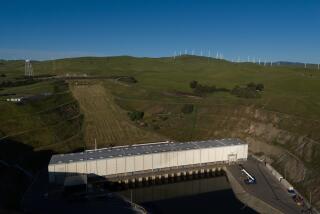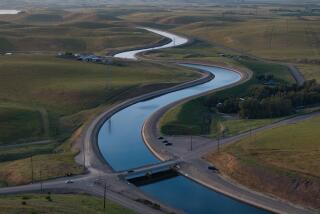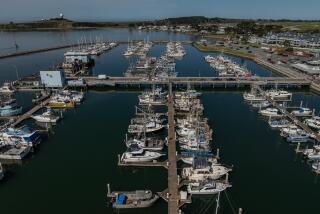The Delicate Act of Juggling Water
MILLERTON LAKE, Calif. — In four roaring funnels, water shoots out of the mouth of Friant Dam at 85 mph, tumbling into a churning pool of froth that looks like a giant tub of cappuccino foam.
The scene is part of a complicated choreography of water releases underway in the San Joaquin River Basin as dam managers try to avert serious flooding in this sodden spring of endless rain and monster snowpacks in Northern and Central California.
Here, 20 miles northeast of Fresno, dam operators have to make room for the coming snowmelt in the smallest reservoir in the big federal water project that greens the Central Valley. But they can’t let out too much water or it will break through the aging, earthen levee system that guards towns and farms downstream.
It is a season of round-the-clock monitoring, canceled vacations and anxious weather readings. “At times like that my body is running at 100 miles an hour,” said Friant operations chief Tony Buelna, who at the beginning of the month, when nature was filling the reservoir to the brim, got a total of four hours of sleep in three days.
With last week’s weather drier than expected, Millerton’s levels were starting to fall and Buelna was getting some sleep. But the potential for disaster will last well into the summer.
In the High Sierra, where the headwaters of the San Joaquin arise southeast of Yosemite National Park, the snowpack is 170% of the norm -- 50 feet deep in some places. When that melts, there will be enough runoff to fill Millerton four times over.
The 319-foot-tall Friant Dam, built at the beginning of World War II and the only one on the main stem of the San Joaquin, is one of nearly a dozen in the drainage basin. There are 10 others on the river’s tributaries, which branch out like vines on a trellis as the San Joaquin runs northwest to its delta just east of San Francisco Bay.
Each of those dams is spitting water into the system from swollen reservoirs, complicating the release calculations. The dam operators are like air traffic controllers, constantly juggling what is coming in and out of their reservoirs. But unlike air controllers, they have little say over what comes in -- and they have to be aware of what every other dam is doing.
With much of the state on flood alert and an emergency declaration in more than a dozen Northern and Central California counties, dam managers consult with each in daily teleconferences. They listen to morning weather briefings and pore over computer models that try to predict runoff based on the temperature, precipitation and snowpack.
They look at maps that plot flow times, showing how long it takes dam releases to reach a particular section of the river, where they will be joined by water from other reservoirs. More maps tell them how much flow the river can handle without surging over its levee walls.
In his office near the base of the dam, bounded by the fresh green Sierra foothills, Buelna taps into a computer program that analyzes San Joaquin records going back to 1896.
His desk is papered with computer printouts. One is covered with hourly readings that track flows in and out of Millerton and precisely how full it is. Others show precipitation and temperature data and how much water is in the smaller hydroelectric lakes above Millerton, in the upper reaches of the San Joaquin.
Thursday, a warm, sunny spring day, Friant was releasing 7,700 cubic feet per second into the river channel, plus an additional 3,000 cubic feet per second into the two big irrigation canals that carry water from Millerton up and down the east side of the San Joaquin Valley. A cubic foot of water will roughly fill a basketball, meaning that each second, 7,700 basketballs of water are spewing out of the base of the concrete dam, sending up 60-foot-tall spray. For a couple of days this month, water was also spilling over the top of the dam gates for a thunderous ride down Friant’s sloping face.
It is a dramatically different scene than one normally encounters at Friant, which was built to keep water out of the river and send it to some of the richest agricultural land in the country. The dam has done such a good job that in the typical summer dry season, the San Joaquin shrivels to nothing in two sections below.
As a result, historically bountiful salmon runs have been wiped out, sparking a long, bitter environmental battle that is poised for a court settlement that could put enough water back into the river to revive those dead spots.
For now, there is no shortage of water, and dam managers are doing everything they can to keep the San Joaquin from running wild. It is a delicate balancing act. If they hold back too much, they can lose control of their reservoirs. And if they let out too much, they can cause flooding.
That happened in 1997, when New Year’s storms swelled reservoirs to the bursting point in Northern and Central California. Buelna opened the dam gates for the first time for a flood release in Friant’s history, unleashing a water surge that carved a destructive path downstream. He and some other dam managers were criticized for not releasing more water in advance of the storms to create room for the sudden runoff.
Buelna, who has run Friant operations since 1990, said the 1997 storms were too powerful to avoid a big release. But he acknowledged he has his critics -- it goes with the job. Now, in places like the little farm community of Firebaugh, where emergency workers have been stacking sandbags atop old levees, Buelna says people are looking up at the huge Sierra snowpack and wishing he would let out more water to create a bigger hole in his reservoir.
At the same time, the U.S. Army Corps of Engineers wants him to limit outflows to make room for releases from other reservoirs.
With Millerton’s water level dropping every day, Buelna thinks he is creating enough room to accommodate the spring runoff. But he harbors no illusions that he is the master of this river system fed by the untamable storms of the Sierra.
One day, he said with an air of fatalism, Mother Nature will deliver more than Friant can handle. “I hope it doesn’t happen on my watch.”
More to Read
Sign up for Essential California
The most important California stories and recommendations in your inbox every morning.
You may occasionally receive promotional content from the Los Angeles Times.











